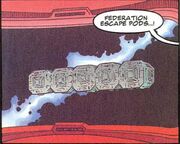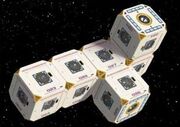The ASRV, or Autonomous Survival and Recovery Vehicle, was a type of escape pod, classed as a lifeboat, utilised by the Federation Starfleet from the 2330s. (TNG reference: Star Trek: The Next Generation Technical Manual; Star Trek: The Next Generation: Build the USS Enterprise NCC-1701-D Issue : "2")
History[]
ASRVs were first introduced with the launch of the last Renaissance-class starship, the USS Hokkaido. The first batch were delivered in the year 2337 and were fitted to the Hokkaido.
Production of 85% of ASRVs were undertaken by automated facilities on Earth, Mars, Rigel IV, and Starbase 326. The remaining 15% were produced at industry second-sources on Velikan V and Rangifer II. (TNG reference: Star Trek: The Next Generation Technical Manual)

Cut-away diagram of a modified ASRV
By the 2350s, a modified version of the ASRV was in production slated for the new Galaxy-class of starships. This new version had minimal changes to both hardware and software. (TNG reference: Star Trek: The Next Generation Technical Manual; Star Trek: The Next Generation: Build the USS Enterprise NCC-1701-D Issue : "2")
In 2354, a batch of minimally modified ASRVs were delivered to the Utopia Planitia Fleet Yards to undergo integration tests for the under-construction USS Enterprise-D. By 2356, 30% of the Enterprise-D's lifeboats had been delivered and docked, and by October 2363 the remaining 70% had also been docked. (TNG reference: Star Trek: The Next Generation Technical Manual)
By 2367, ASRVs were part of the lifeboat complement of other starship classes, including the Nebula-class. (VOY comic: "Ghosts"; TNG reference: Star Trek: The Next Generation Technical Manual)
After Deep Space 9 was turned over to Starfleet control in 2369, 35 ASRVs from other starbase and starship supplies were added to its emergency equipment. (DS9 reference: Star Trek: Deep Space Nine Technical Manual)
By the 2370s an upgraded ASRV was introduced. This new version was larger than the standard version and could accomodate up to nine crew. It was retrofitted to Galaxy-class starships such as the Enterprise-D. (Star Trek: The Next Generation: Build the USS Enterprise NCC-1701-D Issue : "2")
Specifications[]
Standard ASRV[]
The standard ASRV was a truncated cube measuring 3 x 3 x 3 meters with a mass of 1.35 metric tonnes. Amongst other materials, the ASRV was constructed from tritanium, frumium monocarbonite and hafnium cobarate. Propulsion was provided by a ventrally mounted impulse engine, with RCS thrusters at each corner for independent maneuvering. Two hatches - one on either side of the craft - provided access, although a specialized version had an extra two hatches. The ASRV's normal crew capacity was four, although it carried provisions for six if necessary.

ASRVs from the Battle of Wolf 359.
In a ship-board emergency, the ASRV was launched using its ejection initiator which propelled it through the launch channel at a minimum velocity of 40 m/sec. Once clear to navigate, its maximum delta-v was 3,600 m/sec. An automatic environmental system provided life support for up to 86 person-days, with food and water supplies, plus a waste management system included. After ejection, ASRVs were capable of combining, hatch-to-hatch, in clusters nicknamed "gaggle mode". In-space survival rates were dramatically increased due to access to more consumables and supplies, medical personnel, and increased propulsion options.
The ASRV was capable of atmosphere entry and planetary landing, and carried lightweight environmental suits and portable survival packs for when the situation arose. A subspace communication system and automatic distress beacon were included. (TNG reference: Star Trek: The Next Generation Technical Manual)
Upgraded ASRV[]

Interior of the modified ASRV
The upgraded ASRV measured 4 x 4 x 4 meters with a mass of 2.53 tons and had five hatches - one on each side except the ventral surface where the impulse engine was located. This version had seating for six, although it could accomodate nine if necessary, and was capable of providing life support for 160 person-days.
It had a minimum departure velocity of 70 m/sec, and a total delta-v of 5,200 m/sec.

Ejected ASRVs in "gaggle mode"
Each of the hatches were surrounded by electromagnetic grab plates and four male/female docking connectors which assured a solid connection when engaged in gaggle mode. As with the standard ASRV, gaggle mode must be terminated before entry into atmosphere due to the increased demands on structural integrity. On the ventral surface, surrounding the impulse engine, were four landing field emitters which cushioned the craft on touch-down. (Star Trek: The Next Generation: Build the USS Enterprise NCC-1701-D Issue : "2")
